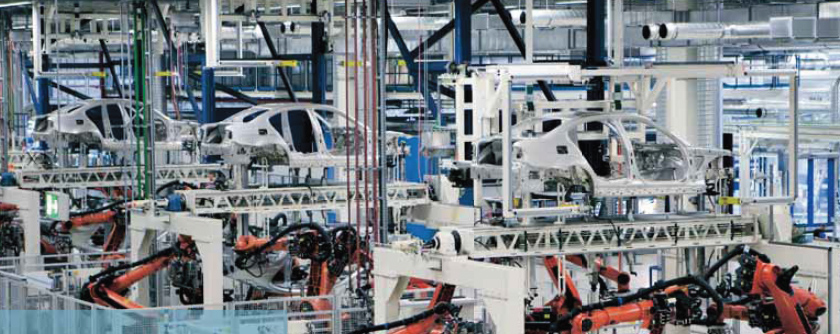
As a vehicle’s largest structure, the body-in-white is deserving of the attention it receives from a process optimisation perspective. AMS looks at the latest trends that give a competitive edge to carmakers and their suppliers
Many of the latest tool and die solutions for body-in-white applications centre on software such as sheet metal forming simulation technology. However, it is only recently that these systems have been applied in proactive ways. Not so long ago, OEMs were using this technology in a ‘reactive’ manner to simulate their own in-house die work to solve problems with tooling after it was fabricated and tried.
Today, OEMs use the technology as a proactive engineering tool. As soon as initial designs become available, engineers scrutinise formability and material yield using simulation software. The results are fed back into the design cycle before any tooling material is cut. A recent trend has seen several OEMs requesting their suppliers to be production engineers, expecting them to provide virtual analysis to support requests for product shape changes or cost-down ideas. It is not satisfactory to simply highlight an area of high compression and potential wrinkles – a solution must also be presented.
Splitting, thinning and wrinkling
One company matching these requirements is StampingSimulation.com. “It is not uncommon for us to engineer a complete process with simulation that produces good parts at first tryout – saving weeks of work on the shopfloor,” says Tim Bliesner, the company’s founding director and chief engineer. “Our mission is to make stamping simulation technology available to the whole industry with our ‘pay-as-you-go’ service model. “Customers only need to send us their part and we will give them any number of simulation outputs, such as splitting, thinning and wrinkling information, blank shape estimates, spring-back analysis and compensation, tip angles and undercut checks, drawing simulation, multiple stage forming, pierce hole roundness checks, and tooling die face data. It is not necessary to buy software or train staff,” Bliesner explains.
From a CAM perspective, Delcam has completed a number of projects involving large-scale press tool manufacture, including automotive body-in-white applications. For example, Korean OEM Hyundai has implemented Delcam’s PowerMILL CAM system in its tool manufacturing operations. Hyundai is unusual among the leading carmakers in that it still manufactures the majority of its press tools in-house at its Ulsan plant.
 “The main benefit of adopting PowerMILL has been a 60 per cent saving in machining times,” reports Sang Han Yu from the Hyundai Tooling Centre. “We have seen a small increase in programming times because we are using more sophisticated strategies, such as offset machining for roughing instead of raster machining. Also, we are making much more use of rest machining and pencil finishing. These also add to the programming time but give us a much better surface finish, which means less hand finishing. Delcam has recently added a number of new options specific to deep-draw press tool design to its Delcam Toolmaker CAD software. Delcam Toolmaker is capable of modelling complex press tools and is used by many car companies and their suppliers for the production of automotive body panels. These new features are aimed at shortening the design time by providing dedicated functionality for many of the tasks involved in preparing the tooling.
“The main benefit of adopting PowerMILL has been a 60 per cent saving in machining times,” reports Sang Han Yu from the Hyundai Tooling Centre. “We have seen a small increase in programming times because we are using more sophisticated strategies, such as offset machining for roughing instead of raster machining. Also, we are making much more use of rest machining and pencil finishing. These also add to the programming time but give us a much better surface finish, which means less hand finishing. Delcam has recently added a number of new options specific to deep-draw press tool design to its Delcam Toolmaker CAD software. Delcam Toolmaker is capable of modelling complex press tools and is used by many car companies and their suppliers for the production of automotive body panels. These new features are aimed at shortening the design time by providing dedicated functionality for many of the tasks involved in preparing the tooling.
The first improvement is a number of automated ways to orientate the part shape to provide optimum tool design. The user can choose between methods that minimise undercuts and overall tool depth or that are based on averaging the ‘normals’ of key surfaces. Another new feature is a form to create the addendum surfaces – the smooth tangential run-offs from the part faces that control the flow of sheet metal during forming. The user selects from a series of standard styles of addendum surface and then completes the form with the necessary dimensions and radii. Again, the software will maintain the tangency between the part surfaces and the addendum surfaces automatically, resulting in a smooth transition between the two.
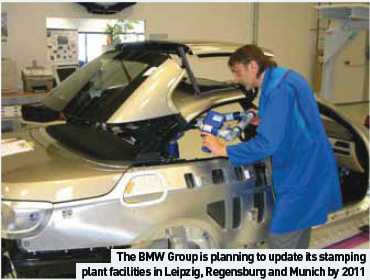 Press shop
Press shop
Sheet metal is first introduced to the production process in the press shop, where the initial contours of what will later become the vehicle are created. While it may seem that the principles of pressing have remained unchanged for many decades, development here is no less diligent and concerted than in other areas of body-in-white manufacture. Arguably, one of the most notable innovations coming to market in the past 18 months is Aida’s ServoPro technology. According to Aida, ServoPro is the first fundamental change in the metalforming industry in more than 30 years. The key is high torque/low RPM servomotors – big motors specifically for press applications.
Connected directly to the crank, the direct drive system provides torque and energy characteristics equal to that of mechanical presses. Furthermore, capacitors store power in the non-working portion of programmable stroke to reduce overall power consumption. A Tier One supplier of parts such as door sashes is already putting the technology to good. Newman Technologies SC of South Carolina has replaced its progressive die operations with an Aida gap transfer system based on ServoPro. The line – five Aida NC1 single point 200T gap frame presses – are connected by the press builder’s A-8 inter-press transfer robot to provide automation.
Pressing matters
Press line selection is the foundation for the entire bodyin- white operation, so getting it right is essential. Another press builder, AP&T has been enjoying considerable success of late in the automotive sector. A case in point is Swedenbased Esskå Metall. When capacity in the company’s automated three-press line became scarce, the company created a new 800m2 addition to its factory. This is now home to a fully-automated, three-press line from AP&T with an automation solution that can handle practically anything. Esskå Metall manufactures a range of body parts and associated components for Scania heavy vehicles. Elsewhere, another company turning to AP&T for a new press line is China’s largest steel producer, Baosteel. The company has decided to develop press hardening technology that it will use when developing future production solutions for the automotive industry.
Baosteel says that the automotive industry’s focus on combining weight savings with increased impact safety has  generated great interest in press hardening as a manufacturing method. The technique makes it possible to manufacture components that are both low in weight and have good ability to absorb energy thanks to a hardening process that makes the material up to three times stronger than standard steel. AP&T provided expertise on the entire press hardening process – from blank feeding, heating and press feeding through to press hardening and ejection. The principal benefit sought by nearly all press shops is increased speed and throughput. Schuler’s Crossbar Feeder technology is an innovative automation system that offers “significant improvements in the machine and process efficiency of mechanical press lines,” claims Joachim Beyer, the Schuler Board of Management member responsible for forming systems large presses/automotive. “With the aid of the Crossbar Feeder II, press lines can reach output of 15 parts per minute in continuous operation.”
generated great interest in press hardening as a manufacturing method. The technique makes it possible to manufacture components that are both low in weight and have good ability to absorb energy thanks to a hardening process that makes the material up to three times stronger than standard steel. AP&T provided expertise on the entire press hardening process – from blank feeding, heating and press feeding through to press hardening and ejection. The principal benefit sought by nearly all press shops is increased speed and throughput. Schuler’s Crossbar Feeder technology is an innovative automation system that offers “significant improvements in the machine and process efficiency of mechanical press lines,” claims Joachim Beyer, the Schuler Board of Management member responsible for forming systems large presses/automotive. “With the aid of the Crossbar Feeder II, press lines can reach output of 15 parts per minute in continuous operation.”
Moving things along
Individual parts can be transported from die-to-die and – where necessary – repositioned, without the need for intermediate stations. Crossbar Feeder II moves directly in the transport direction without a longitudinal crossbar. The short distance between the press centres saves both space and cost, while ensuring good die access. Car body parts are already being manufactured on press lines with Crossbar Feeders in Turkey and China, and now a new high speed line is set for India.
The customer is carmaker Mahindra Automotive, based in Chakan, and the line will be used mainly for the production of body parts for small trucks and delivery vans. It will consist of four linked presses with a total force of 5400T, and be equipped with Crossbar Feeder technology, as well as high-speed blank loader and part unloader. The draw press has a total force of 2400T and a bed surface of 4.6 x 2.5 m. The downstream presses each have a force of 1000T. Another Schuler installation represents the largest order in the company’s history. With a total of three new press lines, the BMW Group plans to update its stamping plant facilities in Leipzig, Regensburg and Munich by 2011. Schuler will install a six-station servo press line in Leipzig by 2009. With a total press force of 10,500T– 2,500T for the leadoff press alone – the line will be tailored to the processing requirements of high and ultra-high strength steels. Parts will be transported by the latest-generation Schuler single-arm transfer system: the Crossbar Feeder, which will help BMW Group operate its Leipzig line at up to 17 strokes per minute. In addition to the three press lines, the BMW Group has awarded Schuler two further orders. In Regensburg, Schuler is to install a blanking line with servo drive; and for its Dingolfing facility, the carmaker has ordered a press for progressive dies with a conventional drive and a press force of 3000T.
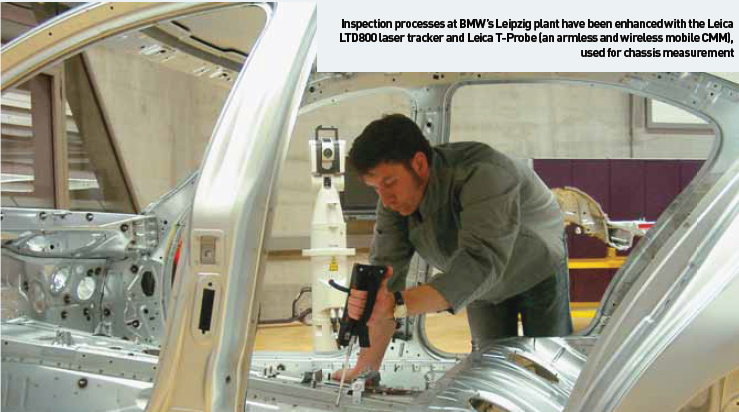 Welding
Welding
The rise to prominence of laser welding for body-in-white applications in recent years has been nothing short of impressive. However, its success is perhaps not surprising considering the numerous advantages to be gained with respect to single-sided access, reduced flange widths, increased torsional stiffness (thus leading to improved vehicle structural performance and/or down gauging of material thickness), less thermal distortion, high speed automated processing and design flexibility in multi-layer joints.
Both laser welding and laser brazing generate a continuous bond line, creating a larger area for load transfer between parts. This results in better crash performance, increased durability and improved torsion and bending stiffness, which in turn makes it possible to down-gauge material thickness and reduce weight. Most car bodies made by automakers now have a significant and growing number of laser-welded components, with greater take-up perhaps only thwarted by higher investment costs and the need for more stringent tolerances on part positioning to ensure a successful result.
Laser-based welding controls the heat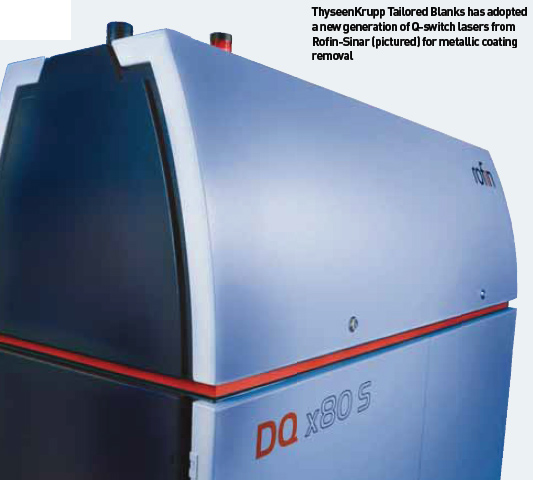
As with any new process technology, as it gathers momentum and media attention, research teams busy themselves by discovering just how far it can be pushed. As an example, the Corus RD&T team in the Netherlands has already developed a process called fluxless laser brazing for joining steel to aluminium during automotive production line assembly.
Until now, the welding of steel to aluminium has been a complicated process and one that poses specific challenges to vehicle makers. For example, when the two different materials are welded, it results in a thick inter-metallic layer that can produce a brittle and weak weld joint. Controlling the heat input using laser-based welding techniques is one way of reducing the thickness of this inter-metallic layer. However, ‘traditional’ laser welding methods require the use of a salt-based flux to enable joint creation. This is not without its problems, as a salt-based flux can make the joint susceptible to corrosion.
The Corus fluxless laser brazing process works by applying an aluminium-based filler wire to create a weld on the 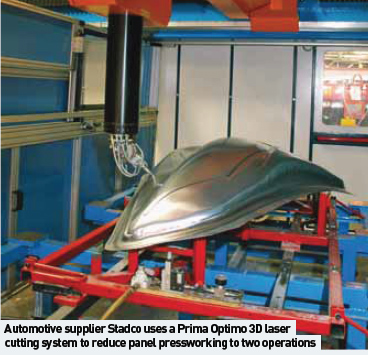 aluminium side of the joint. The molten filler metal then ‘wets’ the steel, creating a brazed joint on the steel side of the weld. Importantly, tests have shown that this new technique creates only a very thin inter-metallic layer, making it possible to create joints that are, in some cases, stronger than the parent materials. “We believe our new welding process is ideally suited to joining aluminium components, for example a roof, to a steel body-in-white, offering vehicle makers further options for saving weight beyond the use of advanced high-strength steels,” says Jurgen Vrenken of Corus RD&T.
aluminium side of the joint. The molten filler metal then ‘wets’ the steel, creating a brazed joint on the steel side of the weld. Importantly, tests have shown that this new technique creates only a very thin inter-metallic layer, making it possible to create joints that are, in some cases, stronger than the parent materials. “We believe our new welding process is ideally suited to joining aluminium components, for example a roof, to a steel body-in-white, offering vehicle makers further options for saving weight beyond the use of advanced high-strength steels,” says Jurgen Vrenken of Corus RD&T.
In another interesting laser welding development, IPG Laser has announced that it has received a major order for multi-kilowatt, continuous wave Ytterbium fibre laser systems totalling 63kW in power from the BMW Group in Munich. These high-power fibre lasers will be used on a new production line at BMW for the welding of automotive doors, with the contract representing the first large-scale production use of fibre laser systems by the German automobile manufacturer. The lasers, which feature integrated cooling systems and beam switches as well as flexible processing fibres, are scheduled to be delivered in Q4 2008.
“We are seeing particular interest in our high-power fiber lasers in automotive applications because of their low maintenance and small footprint on the factory floor,” says Dr Valentin Gapontsev, CEO of IPG Photonics Corporation. Over the past few years solid-state laser technology has evolved from lamp-pumped rod systems to diode-pumped rod systems, and then to diode-pumped disk and fibre laser systems, allowing great improvement in the efficiency and beam quality of welding systems. Laser technology specialist, Trumpf, says that the main reason for this improvement is the use of semiconductor diodes for pumping the laser crystal, emitting only the wavelength of light that is best absorbed by the crystal. Today, optical efficiencies for such systems reach approximately 65 per cent for disk lasers, enabling an overall ‘wall plug’ efficiency of up to 30 per cent, an improvement over lamp-pumped lasers of about ten times.
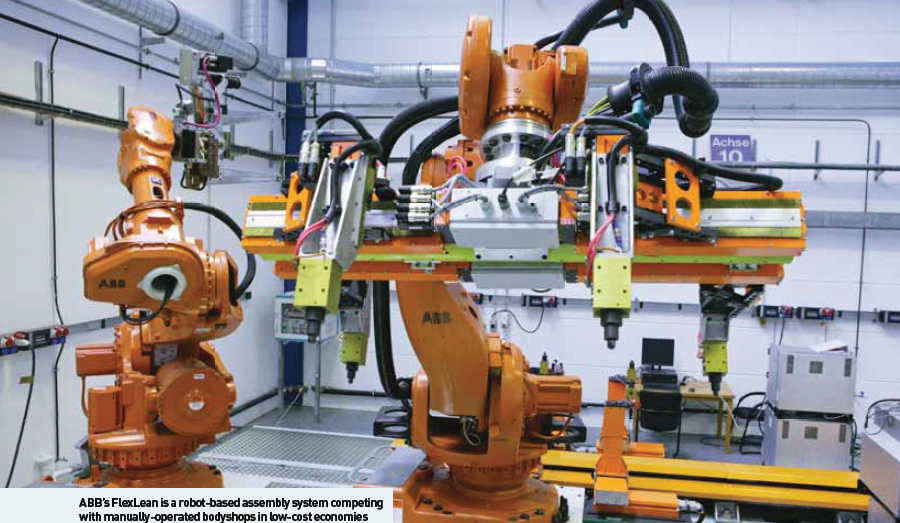 Another main advantage of disk lasers lies in the design of the laser-active crystal. In the case of rod systems, the thermal impact of the pumped light causes ‘lensing’ effects that limit achievable beam quality. However, new disk lasers are designed in such a way that the temperature inside the crystal (known as a ‘disk’) remains constant across its surface. Hence, the beam quality achieved using disk lasers can be much higher than that of rod systems, improving the beam parameter product (BPP) up to six times, says Trumpf.
Another main advantage of disk lasers lies in the design of the laser-active crystal. In the case of rod systems, the thermal impact of the pumped light causes ‘lensing’ effects that limit achievable beam quality. However, new disk lasers are designed in such a way that the temperature inside the crystal (known as a ‘disk’) remains constant across its surface. Hence, the beam quality achieved using disk lasers can be much higher than that of rod systems, improving the beam parameter product (BPP) up to six times, says Trumpf.
Extending the focusing length
The improved beam quality of disk lasers allows for the design of new optical processing heads with longer focal distances, without sacrificing processing speed or focus spot size. According to Trumpf, the beam quality of a 4kW disk laser is three times better than that of a 4kW lamp-pumped laser. This allows a three times longer focusing length while maintaining a focus spot diameter of about 0.6mm, which is still the typical size for deep-penetration welding. The new welding optics can use focal lengths of 500mm and more, helping coin the term ‘remote welding’. Furthermore, the emergence of high beam-quality lasers helps increase the field size of scanner optics, which in turn allows for beam positioning via movable mirrors driven by galvanometer motors. Programming such scanner optics enables processing of any weld shape within the processing area. Trumpf ’s scanner controller systems can be coupled with a robot motion controller to be fully synchronised with the axes of a robot. This allows fast material processing, while the scanner optics is moved in space by a robot to enlarge the processing space and access the part in 3D. Coupling the two systems enables so-called ‘processing-on-the-fly’.
Quick-paced transition of the laser beam from weld-toweld by means of the scanner optics helps reduce lost time from beam repositioning. The velocity of the robot path is typically faster than the effective processing speed of the weld process. When physically looking at the process, it is difficult for the human eye to follow the ‘fireworks’. Most applications in the automotive area are concerned with welding sheet metal between 0.6 and 1.5mm thickness. Trumpf says that in case of welding two 1mm thick sheets, remote welding with a 4kW TruDisk Laser achieves approximately 100mm/sec effective welding speed. Illustrating the growing interest in remote laser welding, Comau has already introduced a remote 3D laser-welding robot. The Comau system comprises an integrated, patented, remote laser focusing and addressing module with a standard anthropomorphic robot from its NH series. The result is a system combining robot motion versatility with laser welding technology, controlled through a single Comau Robotics C4G unit. The 3D system features acceleration of the linear motor up to 8G, while the repositioning speed on the Z-axis is 10 times higher, compared with a standard anthropomorphous robot.
Tailored blanks
Automotive plants wishing to optimise weight reduction, dimensional control, nesting accuracy and scrap management at a reasonable cost have for some time used tailored blanks as a way of tackling some of these challenges. A tailored blank consists of two or more pieces of flat sheet joined together before forming to suit particular applications.
Each component may use different materials, gauge or coating, eliminating the need for reinforcement components or additional spot welding. For these reasons, tailored blanks have become a versatile primary product of body-in-white, and today include rails, panel rockers, panel skirts, door inners and body side outers.
Technology streaks ahead
The common joining method for tailored blanks is laser welding, and laser technology also has a growing role in post processing techniques. For example, Duisburg-based ThyssenKrupp Tailored Blanks has adopted a new generation of Q-switch lasers from Rofin-Sinar for metallic coating removal on its recently developed manganese boron steel tailored blanks.
Available in up to 850W versions, the DQ-Series is providing serious competition to conventional processing methods such as sandblasting and chemical etching, which according to Rofin are both slower and less eco-friendly. The use of manganese boron steel in vehicle manufacture is growing. Compared with conventional steel, the tensile strength of these materials, especially after heat treatment, is much higher, which provides the option to reduce sheet metal thickness without detriment to structure strength, saving weight and improving fuel economy.
However, manganese boron steel is new to tailored blanks because it is coated with aluminum-silicon rather than zinc, due to the higher conversion temperatures required to provide scaling and corrosion protection. Both aluminum and silicon have disadvantageous effects when laser welding tailored blanks, leading to a mixture between parent material and coating in the weld seam.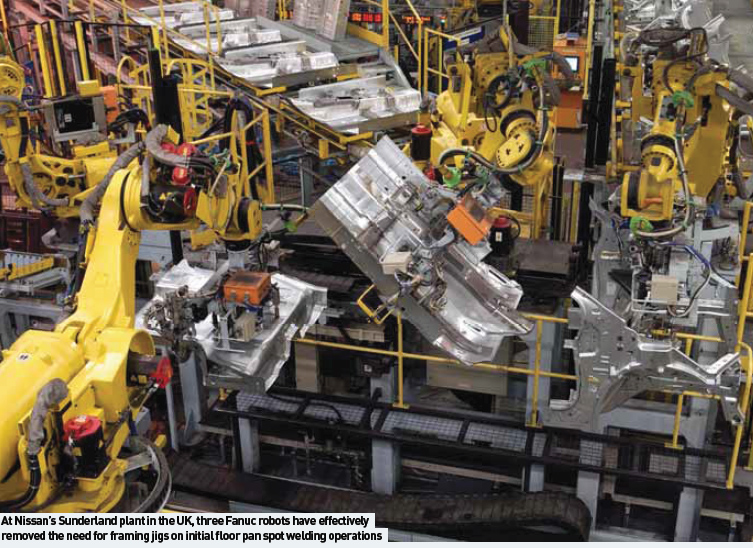
Tests show positive results
The solution is to remove the coating in the weld seam area using Q-switch lasers. Trials at ThyssenKrupp Tailored Blanks witnessed the butt welding of linear sheet material at a feed rate of 10m/min and a removal width of 1mm. Initially the company had been using sandblasting methods on small series production but needed to establish an alternative technique when its customer wanted to raise volume to 30,000 per month late last year. “The cost of continuing with sandblasting would have been immense,” says Jörg Maas, Key Account Manager at ThyssenKrupp Tailored Blanks. “However, the tests with the Rofin lasers showed very positive results: all of our demands, such as the required processing speed and the removal width could be met, so we decided to purchase a 450W DQ laser.”
Q-switch is where the resonator beam path is blocked optically by an active element (the Q-switch), while a laseractivated crystal stores the continuously-applied pumped energy. When the optical barrier is removed, the beam path is opened and all the saved energy is provided within a very short pulse. These short pulses can create top pulse performances that are more than a 1,000 times higher than those provided by continuous-wave lasers.
Lasers
Aside from welding tasks, laser technology is also pivotal in trimming and piercing components used in body-in-white assemblies. A recent case in point can be witnessed at the Coventry, UK plant of Tier One automotive supplier Stadco, where a Prima Optimo 3D laser cutting system is being exploited to reduce panel pressworking to two operations. “Laser cutting technology offers a lot of inherent advantages,” says Manufacturing Engineering Manager at Stadco, Paul Hinsley. “For example, four or five drawing and piercing operations would normally be required to produce the majority of vehicle body closure panels. But, using lasers for component trimming and piercing, we can reduce this to two. Not only do we eliminate several operations, but achieve significant tooling cost savings as well.” The Prima Optimo’s twin cabin configuration also enables components to be loaded in one work area, while the laser head cuts in the other, so minimising downtime. “The machine’s speed has also focused attention on fixture change-over times,” adds Hinsley. “We currently run 20 different programmes on the Prima machine, on panels ranging from 0.9mm to 2.0mm thick, and are working on a project that aims to reduce fixture change-over times to less than 30 minutes within the next few months.”
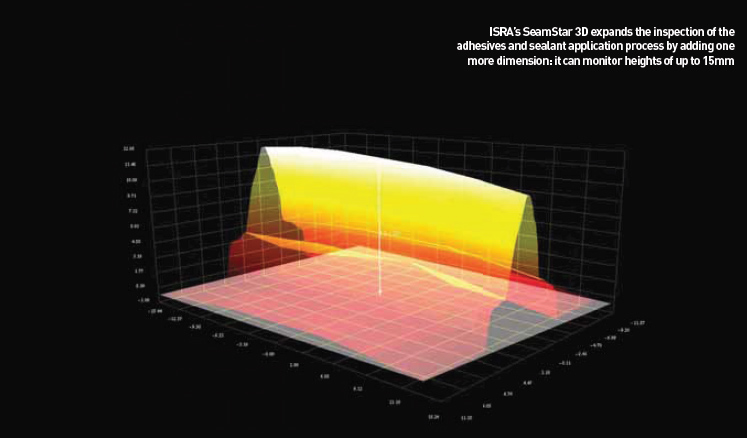 Robotics
Robotics
In modern automotive factories, up to 95 per cent of the processes carried out at the body-in-white stage are automated. Complex automation solutions are required because automotive manufacturers want to offer customers more choice in models while keeping production costs low. Therefore, a single line ought to be able to produce a mix of different models.
ABB’s recently introduced FlexLean is a standard, robotbased assembly system that competes with manually operated bodyshops based in low cost economies. At the heart of the FlexLean concept is the recognition that customised solutions, multiple technical specifications and dedicated software are a major contributor to costs and engineering uncertainty. The answer lies in robot technology and standardisation: two types of FlexLean cells are offered, one for geometrical assembly and one for re-spot. These come with a choice of pre-defined configurations: several process packages (such as spot welding, gluing and roller hemming) are available for the assembly cell, while the number of robots in the re-spot cell is scalable from two to six.
Adjustable system is required
FlexLean consists of various elements, including FlexPLP (Flexible programmable lean positioner), a robot with three positioning axes that is used to support the car body. Previously, jigs would have been used, but with different car models being produced on the same line, and each model requiring a different jig, the case for an adjustable solution becomes clear. Typically, during work the car body or workpiece can be supported on four or more FlexPLPs.
FlexPLP is a good solution to the challenge of tooling flexibility, nevertheless, there still remains the problem of using robots to bring various part types into and out of the production line. Usually, such operations call for several end-effectors with toolchangers. In such a situation, the robot leaves its gripping tool in a docking stand and picks another. The drawback of this approach is the floor space required to store grippers, as well as the resulting effect on cycle times. The Flex-Grip module offers a solution that dispenses with the toolchanger. Instead, FlexGrip consists of adjustable grippers similar in principle to FlexPLP. The resulting module is designed to be carried by a robot. It is lightweight and the critical masses (motors) are located around the interface with the carrying robot. Several such units driven by the IRC5 controller can be used on the robot end-effector to build a programmable ‘gripper’.
ABB recommends its IRB 6600 robot for applications such as body-in-white assembly, and other robot suppliers have also been busy developing solutions in this technology area. Motoman for instance has launched its new SIA20 (slim, individual arm) robot featuring a seven-axis design with high-performance wrist characteristics that enable the machine to manoeuvre in very tight areas. The compact SIA20 has a 16 per cent smaller footprint than Motoman’s previous IA20 model, as well as five-times faster acceleration for improved assembly cycle times.
The need for speed
Remaining with the assembly theme, Fanuc has enjoyed recent success at Nissan’s Sunderland, UK plant, where three robots have effectively removed the need for framing jigs on initial floor pan spot welding operations. Each robot is a Fanuc R2000iA, a six-axis 200kg load capacity arm fitted with a Fanuc V500iA 3DL vision system to locate the panel position.
“The cycle time for the assembly is currently 56 seconds although if required, the line is designed to run at 47 seconds,” says Chris Watt, Engineer with Nissan European Production Engineering. “Where we really benefit is in the ability to produce variants without lengthy toolchange times. Variants are programmed into the robot and the NC tooling controllers – conventional tooling and fixtures are not required. Savings are not only derived from less capital cost, they are ongoing. Conventional tooling gets damaged and also wears out, causing non-intelligent robots to require regular reprogramming. In addition to removing tooling errors, the need to compensate for slack and worn conveyors is removed.”
Aside from assembly, robots are also being developed for use in forming operations so that prototype body parts can be produced without committing to expensive tooling. Welding, of course, remains the principal demand for robotics at the body-in-white production stage. Here, there is plenty of new development bringing added value to the process, such as the ST70L and ST100 robots from Nachi Robotic Systems. These new models come with a 60,000 MTBF and are suited to manipulating lightweight spot welding guns.
Elsewhere, the new KR5 from Kuka not only features high continuous path accuracy, its modular design means it can be integrated into almost any cell concept and can be mounted on the floor or inverted from the ceiling to perform a range of welding or glueing tasks. The demand for robots in body-in-white measurement tasks is also rising, and this will continue now that ISRA has developed an automated way to keep track of all seams. ISRA says that 100 per cent quality inspection of robotguided seaming (plus height measurement) is the only way to adhere to all parameters with tight tolerances. Using its latest sensor head, SeamStar 3D, ISRA says that inspecting the application of adhesives and sealants on body-in-white assemblies becomes even more cost effective, accurate and detailed. To date, image processing systems such as EASI and EASI 3D have proven successful in a total of 23 applications at Opel, VW, Mercedes, Ferrari, Seat, Fiat and BMW, says ISRA.
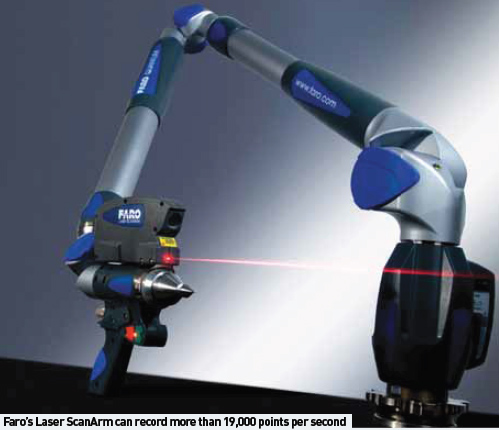 Adding a dimension
Adding a dimension
EASI3D is a three-camera head system that also adopts the function of robot guidance. For this, the system can determine the exact position of the car body part that is to be connected in 3D. SeamStar 3D expands the inspection of the adhesives and sealant application process by adding one more dimension: it can monitor heights of up to 15mm. ISRA says that the speeds which can be reached (up to 500 mm/s) are unheard of in the industry. Yet despite this high speed, an accuracy level of ±0.5mm at 240Hz is attainable, ensuring that a check is performed every 2mm. Measurement
With lasers at the centre of development activity in welding and cutting technologies, body-in-white measurement remains key. Sheet metal applications have always been a prime focus of 3D laser scanning development because body-in-white consists of freeform surfaces and geometric features.
Here, metrology specialists such as Metris have been developing 3D laser scanning technology with capability and productivity benefits that outperform tactile inspection. The latest R&D efforts at Metris have focused on the introduction of a digital inspection process. The first step of this concept digitises the body-in-white to acquire digital point cloud data, which is used in the second stage to derive the inspection outcome. Inspection can then take place at any time, at any degree of detail and for any purpose, without requiring the physical test object. The Ghent plant of Volvo Cars in Belgium is a user of 3D laser scanning solutions from Metris. Until recently, the Geometry Inspection department used traditional tools such as touch probes installed on co-ordinate measurement machines (CMMs) to verify the 3D geometry of components. But this only yielded a limited amount of data that is listed anonymously in tables, making results interpretation challenging.
To streamline inspection processes, Volvo Cars and Metris joined forces in replacing the previous inspection process with optical inspection technologies that support the creation of virtual assemblies. Inspecting inidividual components Volvo Cars acquired a Metris XC50-LS 3D laser scanner mounted on a horizontal arm CMM for the inspection of individual components as well as entire assemblies. 3D laser scanners acquire thousands of measurement points per second that are visualised using a 3D point cloud – a complete digital representation of the surface of the scanned object. The point cloud from the 3D scan is aligned to and compared with the original CAD data, resulting in an error colour chart that reflects local out-of-tolerance geometry deviations.
Geometrical tolerances on assembled bodies are getting tighter: new welding techniques create seam welds that are nearly invisible, while at the same time customers are very sensitive to the appearance of gaps. This point has been recognised at the Poissy plant of PSA in France, where a recently acquired Metris Modelmaker D scanner for non-contact 3D measurement of large vehicle parts has quadrupled scanning productivity over previous optical metrology equipment.
When PSA prototypes vehicle body parts, it closely monitors geometry using Metris MMD to ensure the perfect fit of assembled body elements. Positioning the articulated measurement arm at one or two locations is sufficient to digitise the entire rear of a vehicle body. The technology uses ESP (Enhanced Sensor Performance), an algorithm that adapts camera and laser settings automatically to accommodate varying surface shape and reflectivity.
Enhanced inspection measurements
Laser-based metrology equipment is also having significant effect on inspection processes at BMW’s plant in Leipzig, where a recently installed Leica LTD800 laser tracker and Leica T-Probe (an armless and wireless mobile CMM), is being used for chassis measurement. With the Leica T-Probe, even recesses and cavities can be measured precisely: the length measurement precision is ±0.06mm in a measuring volume of up to 15m. Leica says that during the past 12 months, Daimler and Volkswagen have also purchased the combination of Leica Laser Tracker and a Leica T-Probe.
Elsewhere within the BMW Group, the company’s Regensburg plant is enjoying considerable gains from the use of a Faro mobile Platinum Arm, with a measuring range of 2.4m, and the integrated Laser ScanArm, which has the ability to record more than 19,000 points per second. Reflecting the significant impact of laser technology in modern body-in-white inspection, Faro estimates that nontactile inspection and digital procedures today constitute almost 20 per cent of the market for computer-aided manufacturing measurement activities.


































